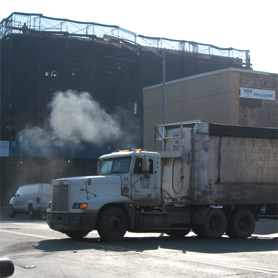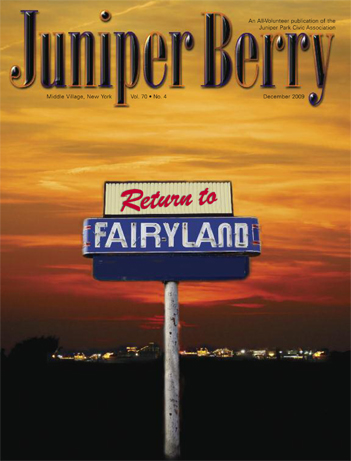Once again the City of New York is dumping on Maspeth and western Queens. This time however the damage can be mitigated with a little planning and foresight. New York City was originally planning to enter into a long-term contract with Waste Management Inc. (WMI) for truck-to-rail or truck-to-barge disposal of all of the DSNY-managed Waste from Queens Community Districts 1 through 6. The NYC Solid Waste Management Plan called for a reduction of truck miles carting garbage out of the city and to use more rail and barge to reduce pollution. The original plan was to rail and barge garbage from the Review Avenue Transfer Station near the Kosciuszko Bridge in Long Island City.
However the Review Avenue Waste Management Inc. facility is not large enough for a rail spur, even though it is located next to the LIRR tracks. Then why not barge the garbage since the Review Avenue Transfer Station is located on the Newtown Creek? According to WMI, carting garbage from six community districts would not be “economically viable” for the multi-billion dollar company. Rachel Amar, a spokesperson for WMI, said several more community districts would have to be included to make it suitable for barging. So Waste Management has proposed a plan consisting of a truck-to-truck-to-rail proposal.
If the truck-to-truck-to-rail export option is selected, the LIRR Maspeth Railyard, located at Maspeth Avenue and Rust St., would be equipped to serve as a staging area for waste loading. In this case, waste would be offloaded from collection vehicles at the Review Ave. site, transferred to dray trucks, and transported to the Maspeth railyard 1.5 miles away for export. If the truck-to-truck-to-rail plan comes to fruition it will generate approximately 81 collection vehicle trips per day and 144 dray truck trips per day and a tremendous amount of pollution for Maspeth. After the garbage is loaded onto railcars in Maspeth the garbage trains will travel through Maspeth, Glendale and Middle Village while working north to eventually go south to the WMI landfill in Waverly, Virginia, a roundabout route to say the least. Glendale and Middle Village residents are already complaining about the stench from these garbage trains.
Because the truck-to-barge plan does not require outbound tractor trailers or inbound and outbound dray trucks, it will result in significantly less traffic than the truck-to-truck-to-rail plan. However, in order to accommodate barge traffic the bulkheads will need to be improved and the sediments adjacent to the bulkheads will need to be dredged. Because Newtown Creek has historically hosted heavy industries that dumped contaminated wastes and given the proximity of the WMI Review Ave. facility to the Keyspan and Phelps Dodge Superfund sites and the Greenpoint Oil Spill; all dredging will require appropriate pollution control measures (e.g. closed clamshell buckets, silt curtains etc.) and all dredged material will need to be disposed of at facilities certified to handle toxic waste. Obviously a financial investment would be needed to accomplish this. That’s the real reason Waste Management Inc. does not want to consider barging.
Emissions from inbound and outbound collection vehicles, inbound and outbound long haul tractor trailers, and on-site waste handling vehicles and machinery all contribute to air pollution in and around the WMI Review Avenue waste transfer station and the Maspeth Avenue railyard. Traffic congestion would also increase significantly around both facilities.
The Waste Management plan would mean truck pollution and traffic in Maspeth and hundreds of “stink trains” on freight tracks traveling through Ridgewood, Glendale, Middle Village and Maspeth with nothing going out by barge. Additionally, the Varik Street Waste Management transfer station (which is listed in Brooklyn will carry garbage on the same rail through our neighborhoods with nothing going through Brooklyn). Trains are the future, but with no emission laws for diesel engines and not enough track lines, trains will continue to idle and couple and uncouple in our backyards spewing toxins into our air and destroying our quality of life, jeopardizing everyones health for Waste Management to make larger profits. Barge would be more fuel efficient and less of an impact to our community. As per recommendations of the S.W.M.P, no more than 50% should go by rail.
There are more reasons not to trust Waste Management Inc. The EPA's National Priorities List of hazardous properties identifies Waste Management as a potential responsible party in connection with 75 contaminated landfill locations (16 of which Waste Management currently owns). Waste Management estimates their liability in connection with these sites at anywhere from $268 to $458 million.
In 1987 the US Government accused Waste Management of violating antitrust laws. They were specifically accused of colluding with other waste haulers to allocate customers in Florida. In 1998, an accounting scandal led to a major drop in stock prices and led to the replacement of top executives, when the new CEO ordered a review of the company's accounting practices. The company had augmented the depreciation time length for their property, plant, and equipment, making their after-tax profits appear higher. The net result was $1.7B in inflated earnings. WM paid $457M to settle a shareholder class-action suit and the SEC fined WM's independent auditor, Arthur Andersen, $7 million for their role.
A better Solution
If Waste Management wants to cart our garbage they should be forced to use either barge or rail directly from their facility. The former Phelps Dodge land in West Maspeth has ample space, a rail spur and docking facilities for a Waste Transfer Station. New York City and State should not approve the Review Avenue facility and force Waste Management to seriously examine a proper location to cart our garbage, preferably by barge.
Research and environmental information gathered by habitatmap.org



